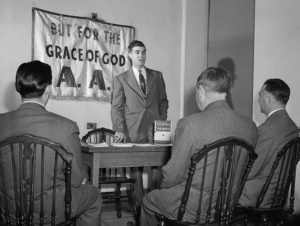I have never seriously asked myself why I went insane when I was young. It didn’t occur to me to ask because I thought it was fate, and who questions fate? I didn’t like to remember what happened to me; or, perhaps, what I did to myself. Those are the two potential narratives for the addict, and they are at poles: victim or persecutor. Which am I? I don’t ask but the tension is always with me. I carry the trauma, which I usually call shame; I carry it in anger and in the fat on my body.
I stopped drinking because I knew I would die, and I wasn’t ready. I went to AA, clinging on to a willingness, if not a pleasure, to live, and recited the dogma. Jonathan Franzen said his friend David Foster Wallace, who killed himself, was so terrified of what he had seen of his id while using, it decimated his trust in his lovability. I understand this perfectly. I know I became a writer to form myself, but I wonder if I invented the person writing these words to disguise the monster that is my true self. I am 20 years sober, and this is my settled state. Fear.
Some addicts think critically about their condition: or they can try. Carl Erik Fisher, a child of alcoholics, is a psychiatrist and he was, during his training, addicted — a phrase that has no settled meaning — to alcohol and pharmaceuticals. He was, “greedily grasping after a new identity for myself”. Fisher used, denied, hallucinated, and collapsed. He believes that denial, a crucial and hitherto mysterious element of addiction, allows the addict to lie more effectively to others, and this makes perfect sense to me. He was tasered by the police in his flat in New York City, “dangerously near the peak of my heart”. He recovered, in the sense that I have: he stopped using. Instead, he wrote The Urge.
It’s a seeking, of course: an attempt to make sense of his life. It is a search for reason because he lost his, and it is as diffuse as his using was simple: just give me more of it. The Urge contains history, memoir, science, miscellanea, literature and polemic. There is a mountain of information out there about drug use — if only we could process it meaningfully — and Fisher read it all, amid his sullen, yet hopeful, quest to return to psychiatry.
It asserts the primacy of the psychiatrist over the primacy of the addict. It is Fisher’s internal conversation with footnotes, and the reader is the listener and, in my case, the patient. Addiction need not, he says — primarily, I suspect, to himself — be a mystery filled with fear.
I found using drugs a return to early childhood state because the feelings I remember are those of childhood: wild freedom; wild hunger; wild sensibility; wild terror. They are life, magnified, and life runs out. Drug use is both a metaphor and a paradigm of the human tension that exists in our consciousness: between the ego and the id (if you are a doctor) and between the sacred and the profane (if you are a priest). It is a truism that they expand our consciousness. For the addict who cannot stop taking them, it expands too much. Then — I speak for me — it dramatically contracts, and that is when I went insane.
But the terror itself moves from the internal life of the addict to society itself. Almost no one here is rational or in control. Most people do not become like Fisher and I, because drugs, he writes, drugs “are not ‘addictive’ in themselves”. They are not the draught of a demon king, then; they need a social hinterland to flourish, which we summon glibly and continually. “Pray for her,” my friend was told when he rang 999 to say I had collapsed with alcoholism, as if medicine had nothing to offer me because I was peculiarly cursed. Yet there is no definitive personality type for a drug addict and no evidence that addiction is genetically determined. Of those who become addicted — those who continue to use long after it is pleasurable and, as AA says, “unto the gates of death” — most get better.
There is a predictable narrative to drug use. A drug is discovered and sold — morphine, cocaine, alcohol, cannabis, oxycontin, LSD. There is an epidemic, a panic, and a repression: a very metaphor for the id itself. Drug epidemics, Fisher writes, are chiefly a response to “social wounding”, which occur when familiar structures fall apart, and drugs are too-easily available. Native Americans suffered a drug epidemic as their lands were stolen. So did the women of Gin Lane, as the population moved from country to town. America is suffering one now, chiefly among whites without a college degree. According to Fisher, there were 150,000 “deaths of despair” in America in 2017. Individual recovery, he says, should not be exempt from social change, but that seems remote.
Those with a full life do not need a fantasy one; or at least, not just a fantasy one. The addicted need treatment and societal change but rather we offer criminalisation. This didn’t happen to Fisher or to me, of course. We are both white and middle class. Yet drug laws are used to criminalise and intimidate vast swathes of society. The War on Drugs, Fisher writes, was really a war on some people who use drugs. White women suck down legal pills in their homes, or drunk themselves insensible and, though they suffer, they do so in comfort. Billie Holliday was hounded to her death by racist prohibitionists.
To wound yourself with drugs you need easy access to them, and we have that: the alcohol industry is worth $1.5 trillion and few of its profits go towards rehabilitation. It’s cheaper to punish the addict: for the manufacturers, at least, who through lobbyists, push the fault onto the individual, and the cost onto the state. Four disparate African nations, Fisher writes, have drug policies drafted by alcohol salesman, and I find that more debasing than anything in Thomas de Quincy’s Confessions of an English Opium-Eater.
Writers tend to make addiction a mystery too thrilling to be solved. Who wouldn’t rather read Hunter S Thompson than ponder the carnage the illegal drugs trade has inflicted on the people of Mexico? The Temperance movement — a drug panic in response to a drug epidemic — commissioned novels like Ten Nights in a Bar-Room and What I Saw There. It was the second best-selling book of the time, after Tom Sawyer. Walt Whitman was paid to write Franklin Evans, a tale of a boy lost to alcohol, which he did, in three days, while drunk. I laughed at this.
Fisher asks: is addiction part of me, or is something apart from the self? Mexican American drug users in southern California, he says, speak of the “tecato gusano” – an indestructible junkie worm that brings evil on the innocent. Addiction, whatever it is, is not boring. It is a battle between good and evil, and within you: something pleasingly self-important for the essentially alienated and prone. I thought of it as a female demon, which now I think was only a strategy to protect the non-demon part: to make her stronger. It was a coping mechanism. I knew it was me. I read Fisher, and I can accept that it was me. Even so, his question is a better way of phrasing the question we have asked for as long as we have used drugs, but have never answered: whose fault is it?
The useful but disappointing answer is we don’t yet know. And perhaps we should stop asking. Perhaps it doesn’t matter. Perhaps it isn’t even a fault. To panic at the altered state of the drug user — to criminalise, to prohibit, to write cautionary, overblown memoir — is to panic at the essential state of being human. And I suspect, that is where the real fear lies.
Disclaimer
Some of the posts we share are controversial and we do not necessarily agree with them in the whole extend. Sometimes we agree with the content or part of it but we do not agree with the narration or language. Nevertheless we find them somehow interesting, valuable and/or informative or we share them, because we strongly believe in freedom of speech, free press and journalism. We strongly encourage you to have a critical approach to all the content, do your own research and analysis to build your own opinion.
We would be glad to have your feedback.
Source: UnHerd Read the original article here: https://unherd.com



